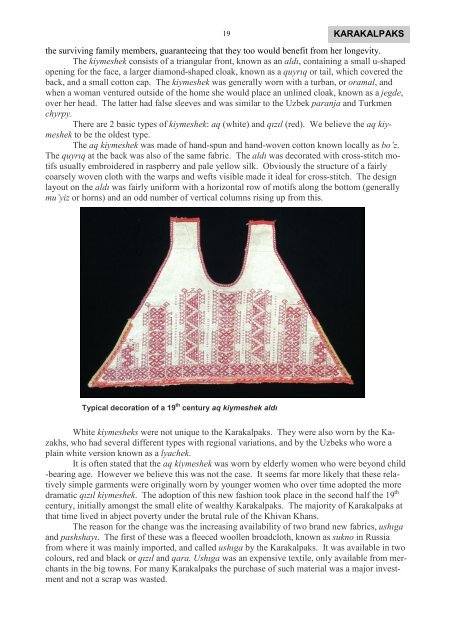Download - OATG. Oxford Asian Textile Group
Download - OATG. Oxford Asian Textile Group
Download - OATG. Oxford Asian Textile Group
Create successful ePaper yourself
Turn your PDF publications into a flip-book with our unique Google optimized e-Paper software.
19 KARAKALPAKS<br />
the surviving family members, guaranteeing that they too would benefit from her longevity.<br />
The kiymeshek consists of a triangular front, known as an aldı, containing a small u-shaped<br />
opening for the face, a larger diamond-shaped cloak, known as a quyrıq or tail, which covered the<br />
back, and a small cotton cap. The kiymeshek was generally worn with a turban, or oramal, and<br />
when a woman ventured outside of the home she would place an unlined cloak, known as a jegde,<br />
over her head. The latter had false sleeves and was similar to the Uzbek paranja and Turkmen<br />
chyrpy.<br />
There are 2 basic types of kiymeshek: aq (white) and qızıl (red). We believe the aq kiymeshek<br />
to be the oldest type.<br />
The aq kiymeshek was made of hand-spun and hand-woven cotton known locally as bo’z.<br />
The quyrıq at the back was also of the same fabric. The aldı was decorated with cross-stitch motifs<br />
usually embroidered in raspberry and pale yellow silk. Obviously the structure of a fairly<br />
coarsely woven cloth with the warps and wefts visible made it ideal for cross-stitch. The design<br />
layout on the aldı was fairly uniform with a horizontal row of motifs along the bottom (generally<br />
mu’yiz or horns) and an odd number of vertical columns rising up from this.<br />
Typical decoration of a 19 th century aq kiymeshek aldı<br />
White kiymesheks were not unique to the Karakalpaks. They were also worn by the Kazakhs,<br />
who had several different types with regional variations, and by the Uzbeks who wore a<br />
plain white version known as a lyachek.<br />
It is often stated that the aq kiymeshek was worn by elderly women who were beyond child<br />
-bearing age. However we believe this was not the case. It seems far more likely that these relatively<br />
simple garments were originally worn by younger women who over time adopted the more<br />
dramatic qızıl kiymeshek. The adoption of this new fashion took place in the second half the 19 th<br />
century, initially amongst the small elite of wealthy Karakalpaks. The majority of Karakalpaks at<br />
that time lived in abject poverty under the brutal rule of the Khivan Khans.<br />
The reason for the change was the increasing availability of two brand new fabrics, ushıga<br />
and pashshayı. The first of these was a fleeced woollen broadcloth, known as sukno in Russia<br />
from where it was mainly imported, and called ushıga by the Karakalpaks. It was available in two<br />
colours, red and black or qızıl and qara. Ushıga was an expensive textile, only available from merchants<br />
in the big towns. For many Karakalpaks the purchase of such material was a major investment<br />
and not a scrap was wasted.
















